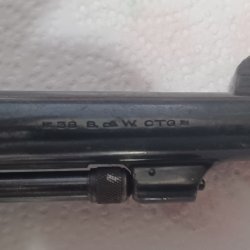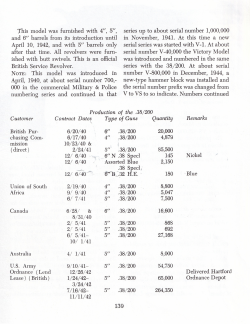You are using an out of date browser. It may not display this or other websites correctly.
You should upgrade or use an alternative browser.
You should upgrade or use an alternative browser.
Help with another identification please
- Thread starter tro55
- Start date
DWalt
Member
I have personally not seen one, but as I previously mentioned, early in the war the Brits were buying up whatever revolvers they could find, even sometimes from US retailers and distributors. In some cases, they would buy commercial M&Ps chambered in .38 Special, then just run a .38 S&W reamer into the chambers. Very simple. You may very well have one of those rechambered commercial .38 Special M&Ps bought in the US by the British Purchasing Commission in 1940.
Last edited:
.38/200 and .38 S&W are the same cartridge with different weight bullets. They are a shorter but larger in diameter cartridge than .38 S&W Special. In order for .38 Special to insert into a cylinder originally chambered for .38/200/S&W, the shoulder in the chamber has to be moved toward the front of the cylinder. That is done by reaming the chamber deeper.Are the sizes different between 38/200,38 s&w and 38 special. DWalt said special reamed to S&w? It is s&w!
The .38/200/S&W cartridge was the British military cartridge. If the British accquired .38 Special-chambered guns, they would have to ream the chambers larger in diameter so their cartridges would insert.
DWalt
Member
Just to clarify ammunition terminology, the .38 S&W cartridge goes back well into the 19th Century, and is one of the earliest American center fire metallic cartridges of the black powder era. It has a slightly larger case diameter than the later .38 S&W Special cartridge, which also has a longer case. The two are generally not interchangeable in the same chamber. The early .38 S&W cartridge in the USA was usually loaded with a 146 grain lead bullet. After WWI, the British decided to replace their .455 military revolvers with something smaller. So what the British did was to take the American .38 S&W cartridge and substitute a 200 grain lead bullet for the old American 146 grain lead bullet. And they then renamed the cartridge as the ".380 Revolver, Mark I." It was NEVER officially called the .38/200 by them. Later on, the laws of armed conflict were rewritten and codified under the so-called Hague Convention. Thereafter, the use of expanding lead bullets in warfare was verboten, as being "too cruel." To comply with The Hague Convention dictates, the 200 grain lead bullet was then replaced by a 178 grain FMJ bullet, and, in time for WWII, the cartridge was renamed by the British as the ".380 Revolver, Mark II.". The Official Commonwealth military nomenclature for the S&W M&P revolver of WWII was actually the "Pistol, Revolver, Smith and Wesson, No. 2," No. 2 meaning .38 caliber. Not sure what the Tommies called it unofficially. Could have been .38/200, could have been K-200, maybe even others. Probably not the Victory Model, which was also unofficial.
Last edited:
DWalt
Member
What I do not understand is why the barrel apparently lacks the normal factory-applied caliber stamp on its side. I cannot think of a good explanation unless S&W was somehow supplying such barrels to British armories. Never heard of that.DWalt,the barrel on mine doesnt show special,just 38 s&w. 4" serial matching.
Rebcop,only mark I see is B on frame under r/s grip.Would that be proof?
Are the sizes different between 38/200,38 s&w and 38 special. DWalt said special reamed to S&w? It is s&w!
Just noticed this. The OP's first post shows the barrel and it is stamped. His picture is below. I thought all guns in theWhat I do not understand is why the barrel apparently lacks the normal factory-applied caliber stamp on its side . . .
early shipments to the UK and Commonwealth countries early in the war were Lend-Lease? If so, since they were to be returned to the US, were the normally not proofed?

Similar threads
- Replies
- 3
- Views
- 750
- Replies
- 10
- Views
- 1K
- Replies
- 23
- Views
- 2K
- Replies
- 15
- Views
- 749

